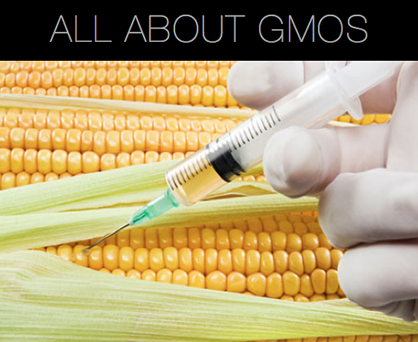GMOs and You: Everything You Need to Know
So you have no doubt heard the term GMO. But do you understand the full implications for your health and our food system that genetically modified organisms present? While GMO crops and ingredients abound, the United States does not currently require companies to label which ingredients have been genetically modified, and the potential side effects of consuming DNA-altered foods are unknown.
GMOs are plants or animals that have been genetically engineered with DNA from bacteria, viruses or other plants and animals through the gene splicing method of biotechnology. This new technology combines DNA from different species, resulting in unstable and experimental meshing of plant and animal genes that never are naturally seen in nature or traditional crossbreeding.
“It is incredible to believe that GMOs are unlabeled and present in more than 80 percent of conventional processed foods, and yet they have not been thoroughly tested to show that they are truly safe for human consumption,” Courtney Pineau, assistant director of the Non-GMO Project, said.
The first commercially produced GMO dates back to 1994, when a crop of genetically modified Flavr Savr tomatoes were introduced to the market. Today, with the vast majority of processed foods containing GMOs, it is highly likely that every time you sit down to eat a meal, at least one of your dishes is serving you up some GMO-contaminated food.
Just because they aren’t labeled doesn’t mean they aren’t harmful. GMO plants can create toxins, contain too little nutrients, become diseased, or malfunction and die, among other side effects.Common GMO crops in the United States include soy (94 percent), cotton (90 percent), canola (90 percent), sugar beets (95 percent), corn (88 percent), Hawaiian papaya (more than 50 percent), and zucchini and yellow squash (over 24,000 acres).
GMOs are not just in crops, but can be hidden in many common processed food ingredients, such as amino acids, aspartame, ascorbic acid, citric acid, sodium citrate, high fructose corn syrup, xanthan gum and vitamins. You may try to avoid soy, for example, by not eating tofu or drinking soy milk, but hidden soy-containing ingredients can crop up in a variety of foods in your pantry.
The effects of consuming GMO crops have not been effectively studied. When foreign genes are combined with existing genes, for example, the functioning of the genes changes, creating new or unknown proteins or decreasing the production of the plant’s existing proteins. The effects of ingesting these proteins have not been determined.

“The truth is genetic engineering is a relatively new and experimental technology that may have significant and unknown impacts on the integrity of the altered DNA,” the Non-GMO Project said.
The positive side of GMOs for consumers is little. Practically all commercial GMOs are modified to withstand direct application of herbicide and to produce an insecticide, and not for consumers’ benefit, such as increased yield or greater nutrition.
Avoiding GMOs can seem overwhelming, so start small – perhaps looking at what you eat for breakfast. Avoiding traditionally farmed produce is far from the answer. Milk, meat and eggs are high risk due to contamination in the animals’ feed. Buying organic can be a useful and certainly healthier step; however, although GMO seeds and ingredients are prohibited by the National Organic Program, organic certification does not require GMO testing. You need to purchase items that are not just certified organic but also non-GMO verified.
The Non-GMO Project conducts a testing system to ensure your products are free of GMOs, the only third-party verification system for non-GMO food and products in the United States. To be verified by the program, the item must be produced in compliance with strenuous and comprehensive standards for each ingredient, including ongoing testing, traceability and segregation, to avoid contamination.
Americans, says Pineau, are likely to be unconcerned about GMOs because of the confusion surrounding genetically engineered crops and animals. Don’t let this happen to you.
“Many consumers do not fully understand what GMOs are, and how they may be impacting our health and food system. However, this is shifting. At the Non-GMO Project we are seeing an incredible amount of concern from consumers about GMOs,” Pineau declared, noting consumer interest is causing demand for non-GMO verification.
More and more, consumers are demanding transparency when it comes to GMO labeling. Thirty states have pending legislation to label genetically modified food products. “In my experience, almost everyone agrees that ‘we all have a right to know what is in our food,’” Pineau said. “I believe that consumers are going to continue to fight for their right to know what is in their food.”
Cross pollination causes contamination. As GMOs continue to proliferate, all crops, including organic ones, are at risk of contamination. Know which crops are high risk and which are monitored as having suspected contamination. The list is frequently changing, so check with an organization such as the Non-GMO Project to keep up to date.
The Non-GMO Project is a nonprofit dedicated to preserving and promoting non-GMO foods, educating consumers, and supplying verified non-GMO choices.For more information, visit www.nongmoproject.org.
Tagged in: wellness, nutrition, health, gmo, non-gmo project,

LadyLUX



